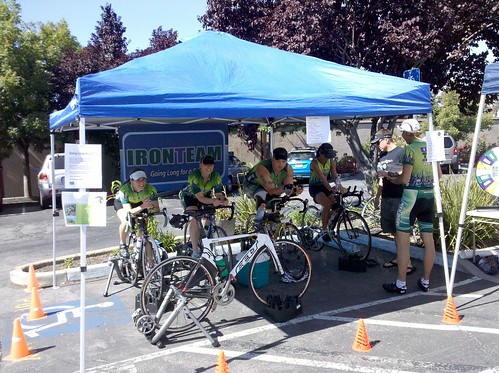
Since I upgraded my cyclecomputer, I’ve ridden 2406 miles. If I were to have driven that distance in my wife’s car, that’s maybe 80 gallons of gasoline. My cyclecomputer tells me that I burned 188,155 calories (food calories, actually a kcal). That’s about 349 big macs or 0.13 barrels of oil equivalent (equivalent to the energy stored in 42 US gallons of crude oil). Less than half (46%) of a barrel is able to be turned into gasoline.. but in terms of gasoline energy, we’re talking 6.288 gallons worth.
So, we’re talking about an order of magnitude improvement on caloric efficiency. This is why the bicycle is such a beautiful machine… when you talk about calories, there’s no more efficient way to get people from point A to point B.
I tend to think that this speaks to the fuel-vs-food debate. In terms of popular biofuels, this is the energy contained within 8.8 gallons of ethanol or 5.4 gallons of biodiesel. Ethanol is less energy-dense than gasoline, so I likely saved more than 80 gallons of ethanol by not driving. Biodiesel is somewhat more efficient, but we’re still talking about at least 10 times the energy requirement.
Ethanol is added, up to 10%, to gasoline. Under 10% and you don’t need to modify the engine much or worry too much about your seals rotting. Above that concentration requires special designs. Initially, gasoline was adulterated with MTBE as an oxygenate to reduce carbon monoxide, although that hasn’t shown to provide much of a benefit in practice. Eventually, as MTBE was shown to contaminate groundwater, Ethanol became the preferred oxygenate. Oxygenates haven’t done much to improve pollution, especially given the three-way catalytic converter also works to reduce the carbon monoxide output. Thus, it is presently sold as a way for us to reduce our need for foreign oil.
This, I might add, reduces the energy density of the fuel. In other words, the same sort of process that leads a drug dealer to cut cocaine with baking soda, giving you unpredictably reduced amounts of high from the same sized dime bag.
The actual energy efficiency of biofuels is subject to debate. Especially compared to food production. Depending on who you ask, it ranges from a net energy loss to a mild energy surplus if you are to produce bioethanol from corn. The energy efficiency of cellulosic production is better.
There are two fairly unarguable truths, however. First, to turn corn into ethanol requires an energy input beyond simply the growing of the corn. Second, for a given piece of land, it is significantly more efficient to put up solar panels than it is to grow any sort of biofuel.
I think I’d rather drink my ethanol instead of burning it in an engine. Or, given that the caloric density if you turn a bushel of corn into corn product is the same or greater than the 2.5 gallons of ethanol fuel, I’d much rather stop at a gas station and pick up some Doritos and high-fructose corn syrup containing gummy candies for my corn fuel instead of ethanol.